I went for a walk at Arkendo Park recently hoping to see some winter ducks if the ice had finally moved offshore. I found a few hundred Red Necked Grebes making odd spooky calls in the fog. I also discovered the birds think this is spring, even if we don’t.
The Trees Are Alive with the Sound of Creepers
No, not Minecraft creepers, these are the cute ones: little Brown Creepers. I spotted my first one a few seconds after reaching the trees. While inching closer to get a better photo of it, another one landed on a maple trunk beside it. Then another flew down to the bottom of a birch.
Everywhere, the air was alive with little two-note contact calls. And if I stood still and looked down and out at the forest, I could see the drop and flutter of wings all around. I was amidst a flock of probably 25 or more Brown Creepers.
Each would work its way up a tree trunk, sometimes straight up, other times circling. They moved so quickly they almost seemed to be flying up. According to the Cornell website, though, they are hopping up . I did notice them using their tails to help balance against the bark. Once at, or near, the top, they quickly stepped off and plummeted, glided, then fluttered onto the next trunk.
If you look very closely you’ll see this bird found a snack.
Very, very rarely would one stop to rest. Most often if one stopped it was to finish eating a larger find. These subtly coloured birds will eat just about anything they find in, on, or under the bark. Spiders, insects, chrysalises: all make a welcome meal.
A Tree Top Flash of Bright Yellow on an Overcast Day
While watching the Creepers, I soon noticed another type of small bird. These ones were zipping from twig to branch at the tops of the trees. Like the Creepers, they rarely stayed still. Their small size and greenish colouring made me suspicious. Sure enough, a closer look showed a combination of black and white eyelines and then the clincher: a vivid yellow stripe on top of the head.
The Golden Crowned Kinglets were also migrating through!
Unlike the Creepers, the Kinglets particularly liked poking around among the branches of the Cedars. I know in the summer our Cedar ends up full of roosting mosquitoes. I suspect that the Kinglets were finding some similar insects resting among the scaly leaves. Certainly there were big black gnat-tish insects here and there in the forest.
A different type of yellow caught my eye while watching one Kinglet. This bird wasn’t flitting from stem to bough to leaf. Instead it was checking a few tree top branches briefly, then flying strongly towards the next tree.
The First of the Warblers
It took a bit of brisk walking to catch up with this one and to swing around in an arc to get a chance to see it in more than silhouette. As I hoped, though, it was a male Yellow Rumped Warbler. In fact, I watched in amusement as a second male dived at the first and drove it away! It couldn’t be a territorial spat this early so it must have just been a surge of irritation.
The male who remained spent the next few minutes checking out various branches of several trees in a decorative crabapple grove. As he flipped and flitted and darted and dodged, I got excellent practice trying to line up a clear shot of a distant warbler in a tangle of twigs.
Yet Another Flash of Yellow
Which is why when I saw another bird in the same tree singing happily and hardly moving, I switched my focus gladly. I thought it would be female Goldfinch judging by the amount of song and the glints and gleams of yellow. It seemed a bit small but I was pretty far away so I wasn’t sure. I do know that despite their relative abundance everywhere I go in the summer I don’t have any really good photos of Goldfinches so I shot quite a few pictures.
It wasn’t till I looked at the first photo at home that I rapidly revised my opinion. Though the bird definitely had crisp wing bars, it also had a vivid white eye ring. And although it had tinges of yellow it was mostly green. I looked at several of my photos hemming and hawing about whether it was a Ruby Crowned Kinglet till finally I reached the next to last shot: where it flashed a peek of its red head top patch at me.
I suspect these Kinglets actually know how bad a birder I am. I had a very similar sequence of photos last spring from a Ruby Crowned visiting my back yard. As if it KNEW I wouldn’t trust my judgment it eventually flashed its crown so I could be sure. (Ruby Crowneds usually keep their red feathers tucked away under a smooth soft green disguise.
But That’s Not All!
While the Brown Creepers, two types of Kinglets and first Yellow Rumped Warblers were all happy discoveries, they weren’t all I saw on this walk. Stay tuned soon for the second part of this spring show.
Related Reading
- Long Tailed Ducks Flip their Feathers at Arkendo Park, Oakville, Ontario
- Rambling through Riverwood Conservancy in April in Mississauga, Ontario: Part 2
Join In
Have the Kinglets made it back to your neck of the woods? Do the Ruby Crowneds take pity on you and eventually permit a glimpse of their definitive field mark? Please share a comment with your experiences.

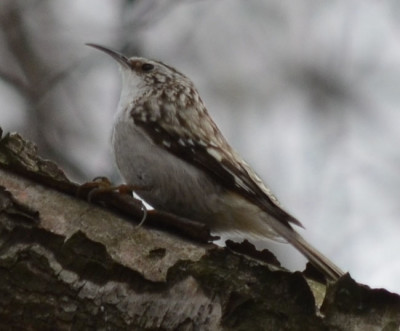

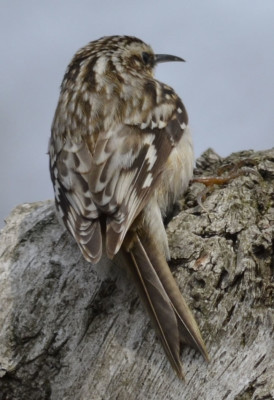

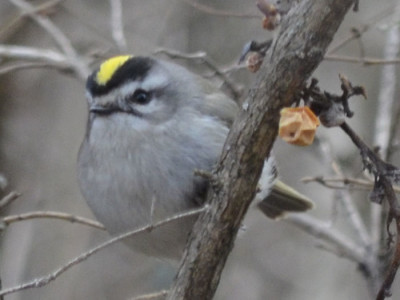
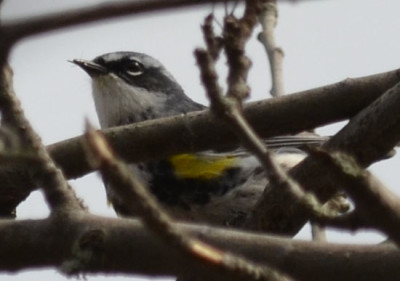
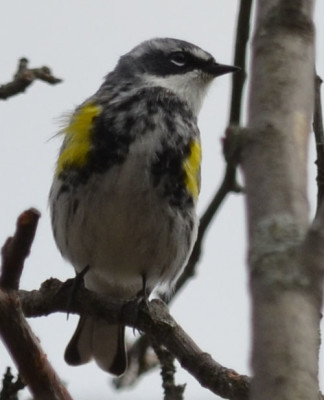

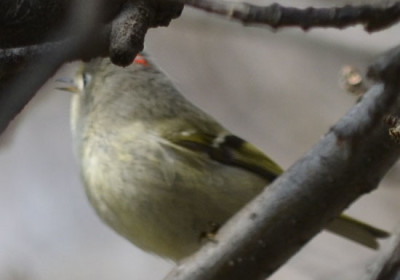
I am still waiting for the surest sign of spring in my neck of the woods (ok, my back yard). Every spring, we get a flock of about 50 Cedar Wax Wings coming to eat the crab apples off our tree. We haven’t seen them yet!
Here’s hoping they’re winging their way towards your yard!
(Today we have over an inch of new snow. I’m sure the Warblers are not impressed.)